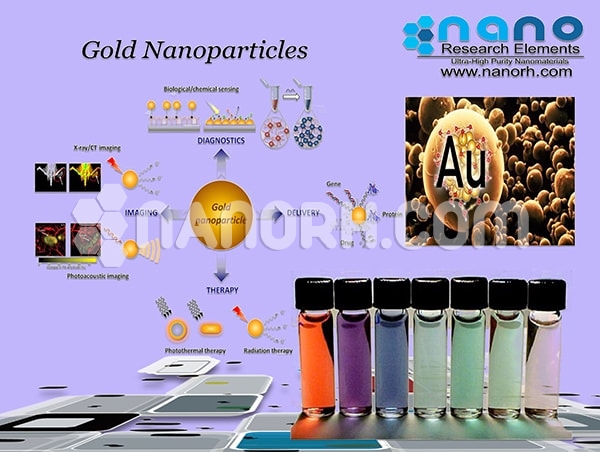Gold Nanoparticles (Au NPs)
Gold Nanoparticles (Au NPs)
INTRODUCTION
Gold nanoparticles (Au NPs) are widely utilized in bionanotechnology supported their distinctive properties and multiple surface functionalities. The benefit of Gold nanoparticles (Au NPs) functionalization provides a flexible platform for nanobiological assemblies with oligonucleotides, antibodies, and proteins. Bioconjugates of Gold nanoparticles (Au NPs) have conjointly become promising candidates within the style of novel biomaterials for the investigation of biological systems.
The versatility of Gold nanoparticles (Au NPs) has provided helpful materials for a spread of medical applications. In medicine, the binding event between the analytes and also the Gold nanoparticles (Au NPs) will alter the chemical properties of Gold nanoparticles (Au NPs) like surface plasmon resonance, physical phenomenon, and oxidoreduction behavior, resulting in detectable signals. Gold nanoparticles (Au NPs) conjointly function sensible platforms for therapeutic agents, with their high extent permitting a dense presentation of multifunctional moieties.
IMPORTANCE
Gold nanoparticles’ interaction with lightweight is powerfully set by their setting, size and physical dimensions. Periodic electrical fields of a lightweight ray propagating close to mixture nanoparticles act with the free negatrons inflicting a united oscillation of electron charge that's in resonance with the frequency of actinic ray. These resonant oscillations square measure called surface plasmons. for little (~30nm) monodispersed gold nanoparticles, the surface plasmon resonance development causes associate degree absorption {of lightweight of sunshine} within the blue-green portion of the spectrum (~450 nm) whereas red light (~700 nm) is mirrored, yielding a fashionable red color. As particle size will increase, the wavelength of surface plasmon resonance connected absorption shifts to longer, redder wavelengths. Red lightweight is then absorbed, and blue lightweight is mirrored, yielding solutions with a pale blue or purple color. As particle size continues to extend toward the majority limit, surface plasmon resonance wavelengths get into the IR portion of the spectrum and most visible wavelengths square measure mirrored, giving the nanoparticles clear or clear color. The surface plasmon resonance will be tuned by variable the scale or form of the nanoparticles, resulting in particles with tailored optical properties for various applications.
This development is additionally seen once excess salt is extra to the gold answer. The surface charge of the gold nanoparticles becomes neutral, inflicting nanoparticles to a combination. As a result, the answer color changes from red to blue. to attenuate aggregation, the versatile surface chemistry of gold nanoparticles permits them to be coated with polymers, tiny molecules, and biological recognition molecules. This surface modification permits gold nanoparticles to be used extensively in chemical, biological, engineering, and medical applications
APPLICATIONS
The varieties of applications for gold nanoparticles are growing day by day and include:ELECTRONICS
The Gold nanoparticles square measure designed to be used as conductors from printable inks to electronic chips. Because the world of natural philosophy becomes smaller, nanoparticles square measure vital elements in chip style. The nanoscale gold nanoparticles square measure being employed to attach resistors, conductors, and associate degreed different parts of an electronic chip.PHOTODYNAMIC MEDICAL CARE
Near-IR interesting gold nanoparticles (including gold nanoshells and nanorods) turn out heat once excited by lightweight at wavelengths from 700 to 800 nm. this permits these nanoparticles to eradicate targeted tumors.2When lightweight is applied to a tumor containing gold nanoparticles, the particles chop-chop heat up, killing tumor cells in a very treatment conjointly called physiological state medical care.THERAPEUTIC AGENT DELIVERY
Therapeutic agents may also be coated onto the surface of gold nanoparticles. The large surface area-to-volume quantitative relation of gold nanoparticles permits their surface to be coated with many molecules (including medicine, targeting agents, and anti-fouling polymers).SENSORS
Gold nanoparticles square measure employed in a spread of sensors. for instance, a quantitative chemical analysis detector supported gold nanoparticles will determine if foods square measure appropriate for consumption.4 different ways, like surface increased Raman spectroscopic analysis, exploit gold nanoparticles as substrates to alter the mensuration of undulation energies of chemical bonds. This strategy might even be used for the detection of proteins, pollutants, and different molecules label-free.PROBES
Gold nanoparticles conjointly scatter lightweight and may turn out associate degree array of fascinating colors beneath dark-field research. The scattered colors of gold nanoparticles square measure presently used for biological imaging applications. Also, gold nanoparticles square measure comparatively dense, creating them helpful as probes for transmission microscopy.DIAGNOSTICS
Gold nanoparticles are wont to find biomarkers within the identification of heart diseases, cancers, and infectious agents. They’re conjointly common in lateral flow immunoassays, a standard unit example being the mouse bioassay.CATALYSIS
Gold nanoparticles square measure used as catalysts in a very range of chemical reactions. The surface of gold nanoparticles will be used for selective oxidization or in sure cases the surface will scale back a reaction (nitrogen oxides). The gold nanoparticles square measure being developed for cell applications. These technologies would be helpful within the automotive and show trade.FUTURE PROSPECTS
An interesting space, that values following, is to review the synthesis, procedures, and applications of gold nanoclusters. Gold nanoparticles synthesis could be a well-explored field in engineering, reaching across several areas like chemistry, physics, and biology. However, gold nanoclusters synthesis could be a comparatively new field still in development. The isolation and purification of gold nanoclusters has been a recent scientific accomplishment, resulting in thorough investigations of each its structure and its implications.
Gold Nanoparticles

